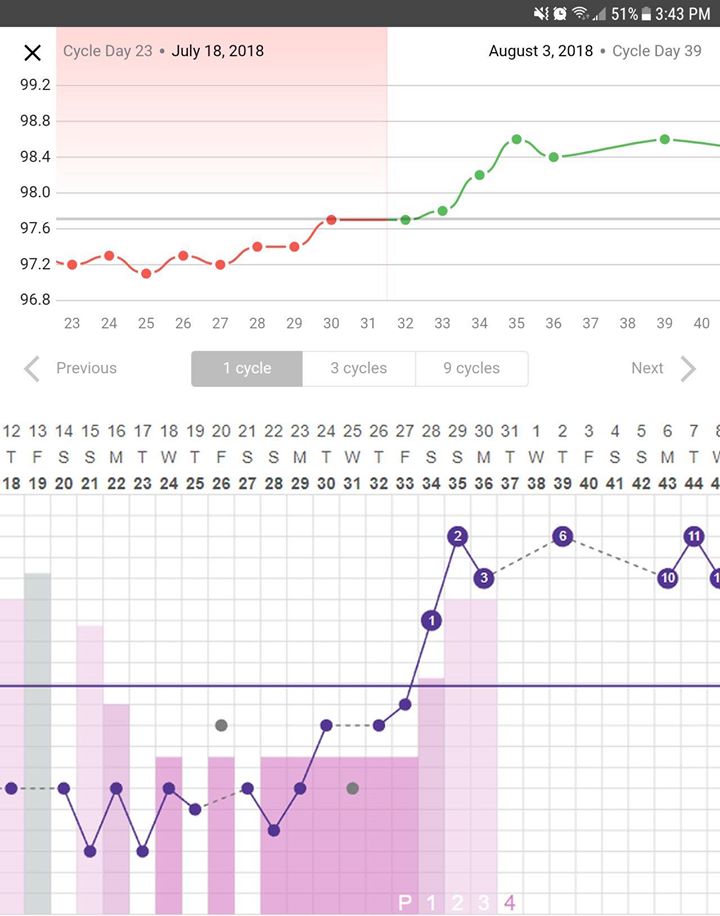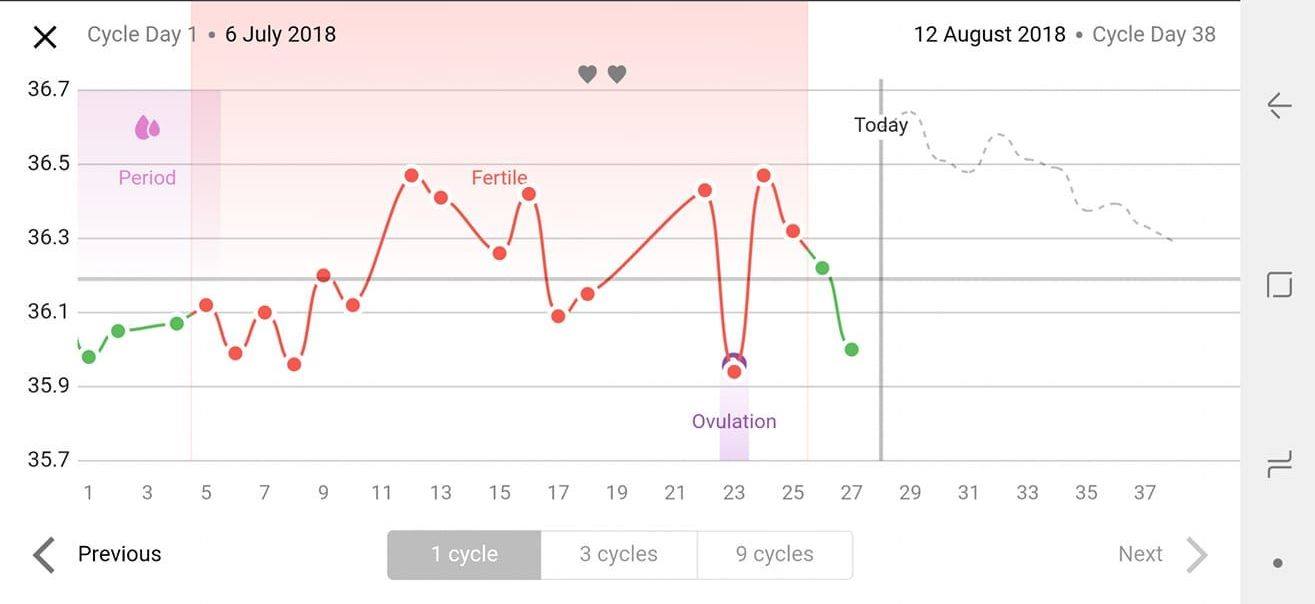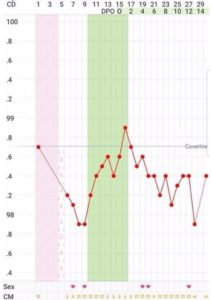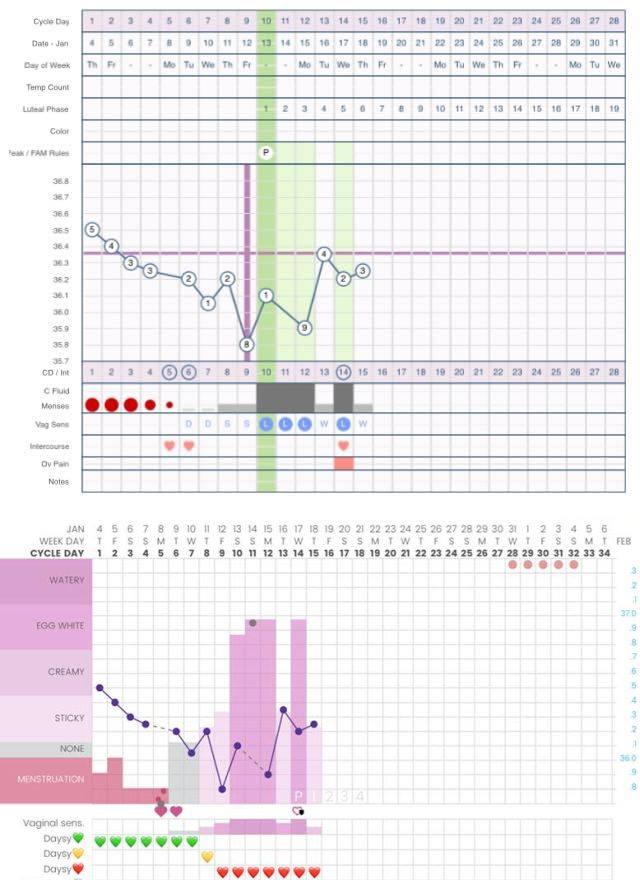So you’ve downloaded a FAM charting app (such as Natural Cycles) or purchased a FAM device (such as Daysy). Now what? Seems like turning on the ovulation & menstruation prediction features is the best place to start, right? THINK AGAIN! It’s time to turn off predictions and empower ourselves with knowledge!
Many apps/devices proclaim their ability to accurately predict ovulation and menstruation. But how accurate are they, really? What are these predictions based upon? And what’s at stake when predictions are trusted?
Before answering these questions, we need to think critically about what FAM teaches us: how to accurately identify the opening and closing of our fertile window (during which ovulation occurs), based on obvious and scientifically valid fertility signs that we can independently observe on a daily basis: cervical mucus, cervical position, LH tests and/or basal body temperature, depending on your chosen method. The practice of FAM teaches us body literacy: the ability to ‘read’ your own fertility signs independently and ascertain information about each unique cycle, your health, your hormonal state, and your fertile/infertile days. Predictions disregard body literacy and promote dependence on external technology, which is inaccurate at worst and misleading at best. Here’s the thing: the time of our fertile window (and ovulation) is subject to change each and every cycle for our entire reproductive lives. If you’re new to FAM, this may be surprising to hear. Most of us have always been taught that “normal menstrual cycles are 28 days and ovulation always occurs right on or around day 14.” Not only do normal cycles vary in length from one woman to another, as well as within an individual woman’s cycle history, but the time when ovulation occurs in each cycle varies as well. This is where predictions can be totally inaccurate for individuals. Fortunately, FAM teaches us not to make assumptions or predictions because of the natural variability of our cycles and to only to rely upon actual CM & BBT evidence.
“But my cycles have ALWAYS been regular, for my entire life!”
Unfortunately, past cycles are not a predictor of future cycles. The assumption that past cycles are predictive of future cycles is ‘rhythm method thinking’ and often opposes actual evidence provided by our observable fertility signs. It only takes 1 stressful life event, lifestyle change, diet change, or travel event to delay ovulation or cause an early ovulation, resulting in a different cycle from your expected norm. Proper FAM charting accounts for these variables, but app predictions do not and cannot.
App predictions rely upon data averages, rather than your current, scientifically valid fertility signs. This creates confusion.
It is problematic because they can cause you to doubt your actual observable fertility signs and invest more weight in the predictions. Even if you’ve been lucky enough that predictions were okay in the past, or even if you have multiple ‘ovulation tracking’ apps that all seem to form a consensus about your predicted ovulation, ovulation cannot be predicted accurately by app averages.
What’s at stake when predictions are trusted – when charting to avoid, conceive, or for health?
- Charting to Avoid: Unintended pregnancy is the biggest risk when relying upon app predictions for your fertility status. When following app predictions rather than the studied and effective rules of a FAM, the risk of pregnancy is much higher.
- Charting to Conceive: Delay of conception due to timing sex incorrectly with your actual fertile window. The ovulation prediction of an app may be completely different than your actual fertile window. This added stress can be very dismaying for couples.
- Charting for Health: The point of charting for health is to gain and practice body
literacy by becoming an active participant in our own health – this means checking our cervical mucus independently and taking our BBT daily, in order to establish a read on our hormonal state, luteal phase length, etc. Menstruation predictions may be completely off, causing unneeded stress or worry upon an individual about whether their cycles are “normal.”
“But I’m not RELYING on the predictions, I just like having them there as an extra layer of security.”
We’ve all been there, and I get it. But I would encourage you to take a moment and reflect: why is it that we need to trust unreliable app predictions rather than our own knowledge and ability to apply that knowledge? FAM provides us with a wealth of information to help us gain body literacy and understand our fertility – it’s time to learn! If you’re unsure, it’s time to ask questions!
Apps & Devices that we do NOT recommend!
Please note that essentially all charting/period tracking apps have at least some level of predictions or auto-marking built in. Some apps allow you to toggle these off, some do not. The main problem arises when an app or device claims to INTERPRET YOUR CHART FOR YOU and tell you definitively when you are fertile or infertile. The following popular apps/devices are notoriously problematic when it comes to predictions and are not good choices for FAM:
- Natural Cycles app: Temps-only, no way to track CM/CP within their app. This app has you input your temperature and then tells you each day if you are safe to have unprotected sex. We’ve seen risky chart after risky chart within this group as well as pregnancies resulting from following NC predictions. Here’s a couple articles with more details: bit.ly/2HuUukW & bit.ly/2K3t4WK


- Daysy device & app (LadyComp, BabyComp, Pearly): An expensive ($300+) thermometer that simply displays a red, yellow or green light based on an algorithm to indicate current fertility. We’ve seen many a risky green light from this device as well as pregnancies. The most common advice given when someone asks about these devices is “if you have this much money to spend, use it on a FAM instructor instead!” Daysy claims a 99.4% efficacy. Here’s a post by a researcher in our group who raised concerns about the “study” Daysy had done to get that 99.4% figure (the study has been retracted): bit.ly/2Vt1L9L

- Glow app: A variety of stuff can be tracked but the app seems to simply follow the rhythm method regardless of data input. % risk of pregnancy is given each day which is super misleading and earns this app a special honorable mention. A risky day is a risky day!

- Ava device & app: This is a wearable device with a companion app. Geared towards TTC. Do not use the built-in fertility predictor (especially if you are avoiding pregnancy) but it may be OK to use this as a simple thermometer and make your own interpretations. However, we have had some users experience problems even with this strategy. In addition, wrist temps are not considered acceptable by evidence based FABMS. Here’s a post detailing some potential problems with the Ava app interpretations: bit.ly/2JGtamc
- OvaGraph app: We’re going to pick on this one just a little bit because it is the official TCOYF companion app, yet does not follow TCOYF rules for auto-marking your chart, and does not allow for manual interpretation (or even to switch off the automatic one!) While it does not “give you permission” to have unprotected sex like Daysy/Natural Cycles, it’s a good example of an app auto marking ovulation day for you and getting it wrong often.

So what SHOULD we look for & trust in a FAM app?
A great FAM app empowers the user to…
- Turn off predictions and rely upon their own knowledge & body literacy
- Record daily basal body temperature & cervical mucus (and preferably CP too)
- Mark their own Peak Day, Coverline, and Temperature Shift (HINT: IMPORTANT!!!)
- Independently decide which days are fertile / infertile based on studied and reliable rules
Some great FAM apps meeting these requirements include, but are not limited to:
- Kindara (ignore/replace any auto-marked coverline etc)
- Fertility Friend (turn off automatic functions first; choose Manual override)
- Justisse web charting app (input info on phone or computer, full chart viewable on computer)
- OvuView (with some creative setup, see here: bit.ly/OvuViewTips)
- Creating your own paper/spreadsheet charts